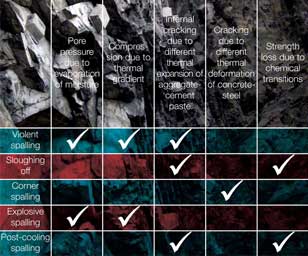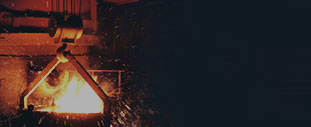

eal” spalling can occur in different forms, each of which is caused by a specific combination of the following mechanisms:
Pore pressure rises due to evaporating water as the temperature rises;
Compression of the heated surface due to a thermal gradient in the cross section;
Internal cracking due to differences in thermal expansion between aggregate and cement mix;
Cracking due to differences in thermal expansion/deformation between concrete and reinforcement bars;
Strength loss due to chemical transitions during heating.
The mechanisms act on different scales:
MACRO-LEVEL Concrete considered as a grey homogeneous material with uniformly distributed material properties. On this level, the thermal stresses that result from the thermal gradients over the cross section must be considered, taking into account the actual geometry, support conditions and loading configuration.
MESO-LEVEL Concrete considered as a mix of aggregate and cement mix, each with its own material properties. On this level, the cracking due to differential thermal expansion between aggregate, mortar and reinforcement must be considered.
MICRO-LEVEL Cement mix, aggregate particles or interface layers considered as a mix of chemical constituents. On this level, the pore pressures and the degradation of mechanical properties due to chemical transitions and dehydration must be considered.
During fire tests the observations of spalling of concrete cover a wide range. These are, in random order: observation of spalling with slow (1°C/minute) or fast (250ºC/minute) heating, from gradual to explosive spalling, cracking along or through aggregate grains, spalling in the beginning of the fire or after some time, stopping after some time or progressing, stopping at the reinforcement level or continuing far beyond it, and so on. The different observed spalling phenomena are described below, including their relationship to the previously mentioned mechanisms (see also Breunese & Fellinger, 2003).
 A summary of the relationships between type of concrete spalling and spalling phenomena. [Click to Enlarge]
A summary of the relationships between type of concrete spalling and spalling phenomena. [Click to Enlarge]PROGRESSIVE GRADUAL SPALLING (SLOUGHING OFF)
Sloughing off is the form of spalling that is caused by strength loss due to internal cracking (mesolevel) and chemical deterioration of the cement mix (micro-level). This type of spalling is related to the attained temperature of the concrete (instead of heating rate). If the concrete is heated to a very high temperature the strength will be too low to carry its own weight, causing small pieces of concrete to fall down without much sound. This type of spalling is likely to occur on a slab heated from below, since gravity will force the cracked pieces of concrete from the cross section.
CORNER SPALLING
Corner spalling is the type of spalling that occurs when a corner of concrete breaks off at the location of a reinforcement bar. Inhomogeneous heating of concrete leads to a deformation (ovalisation) of the concrete around the uniformly heated reinforcement bar. This difference in deformation causes splitting stresses in the concrete, leading to splitting cracks that can cause the corner of a column or slab to break off.
EXPLOSIVE SPALLING
Explosive spalling is the result of a combination of rising pore pressures and thermal gradients in the cross-section. At the front of heat penetration, a “moisture clog” (an area with high pore pressure) develops inside the concrete. Part of the moisture is pushed further into the colder part of the concrete due to the pressure gradient at the back of the clog. If the heated surface is under compression due to a thermal gradient, the complete heated surface may explode away with a loud bang. This type of spalling is especially likely to occur on structural members heated from more than one side, such as columns and beams. When moisture clogs are advancing into the concrete from all heated sides, at some point in time the moisture clogs will meet in the centre of the cross section, creating a sudden rise in pore pressure which may cause large parts of the cross-section to explode. This type of spalling can also occur after a considerable duration of the fire even if the concrete surface has been protected with an insulating layer. (Both, 1999)
POST-COOLING SPALLING
Post cooling spalling occurs after the fire is over, after cooling down or maybe even during extinguishing (Khoury, 2003). This type of spalling was observed with concrete types containing calcareous aggregate. An explanation is the rehydration of CaO to Ca(OH)2 after cooling, with an expansion of over 40% occurs after cooling down, when moisture is again present on the concrete surface. The expansion due to rehydration causes severe internal cracking on the meso-level and thus complete strength loss of the concrete. Pieces of concrete keep falling down as long as there is water to rehydrate the CaO in the dehydrated zone.








